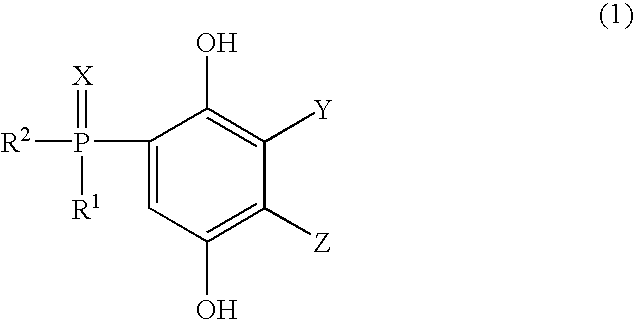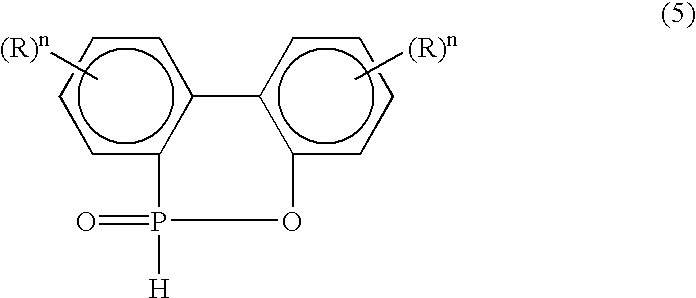Phosphorus-containing hydroquinone derivatives, process for their production, phosphorus-containing epoxy resins made by using the derivatives, flame-retardant resin compositions, sealing media and laminated sheets
a technology of hydroquinone and derivatives, which is applied in the direction of transportation and packaging, group 5/15 element organic compounds, and other chemical processes, can solve the problems of increasing the phosphorus content of epoxy resin, deteriorating the moldability of compound materials, and increasing flame retardancy, etc., and achieves low cost
- Summary
- Abstract
- Description
- Claims
- Application Information
AI Technical Summary
Benefits of technology
Problems solved by technology
Method used
Image
Examples
production example 1
[0174] A reactor was filled with 1843 g (16.69 mol) of 1,5-cyclo octadiene (available from Tokyo Chemical Industry Co. Ltd.) and 3750 ml of toluene, and the reactor was fully purged with nitrogen. Subsequently, 731 g (21.50 mol) of phosphine (available from Nippon Chemical Industrial Co. Ltd.) was added to the reactor and the temperature was increased to 60.degree. C. As a radical initiator, 58.8 g (0.237 mol) of 2,2-azo bis-(2,4-dimethyl valeronitrile) (available from Japan Hydrazine Company, Inc.) was introduced under pressure for 3 hours. The resultant material was aged for one night at 60.degree. C. to obtain a toluene solution of a mixture consisting of 1,4-cyclooctylene phosphine and 1,5-cyclooctylene phosphine (purity of the mixture was 31.9% weight, the ratio of 1,4-cyclo octylene phosphine:1,5-cyclo octylene phosphine was 38.4:61.6 (GC relative areal ratio)).
[0175] A 2000 ml four-neck flask equipped with a stirrer, a condenser and a dropping funnel was fully purged with nit...
example 1
[0177] A reactor equipped with a stirrer and a temperature indicator was fed with 900 ml of toluene and 183.5 g (total purity was 87.0%, 1.00 mol) of a mixture of 1,4-cyclooctylene phosphine oxide and 1,5-cyclooctylene phosphine oxide produced in the aforementioned Production example 1 at room temperature, and the solution was stirred to be dissolved. After the reaction solution was heated to 70.degree. C., 108.7 g (1.00 mol) of a fine powder of 1,4-benzoquinone was gradually added for 3 hours. After the completion of the adding operation, the product was aged for approximately one hour at 70.degree. C., and thereafter the product was cooled to room temperature and filtered to obtain a precipitated product. The precipitated product was then washed with cool methanol three times and then dried under reduced pressure at 80.degree. C. to obtain 192.7 g (0.724 mol) of a mixture of 1,4-cyclooctylene phosphonyl-1,4-hydroquinone and 1,5-cyclooctylene phosphonyl-1,4-hydroquinone in the form...
example 2
[0182] A reactor equipped with a stirrer and a temperature indicator was fed with 500 ml of toluene and 200 g (1.89 mol) of diethyl phosphine oxide at room temperature, and after the solution was heated to 70.degree. C., 299 g (1.89 mol) of a fine powder of 1,4-naphthoquinone was gradually added for 3 hours. After the completion of the adding operation, reaction was carried out for approximately one hour at 70.degree. C., and thereafter the product was cooled to room temperature, and filtered to obtain a precipitated product. The precipitated product was then washed with cool methanol three times and then dried under reduced pressure at 80.degree. C. to obtain 361 g (1.37 mol) of diethyl phosphonyl-1,4-naphthalenediol in the form of a buff yellow crystalline powder. The yield was 72.3%.
[0183] .sup.1H NMR (300 MHz, CD.sub.3OD): .delta. 0.90-1.12 (m, 6H), 2.11-2.58 (m, 4H), 6.60 (s, 1H), 7.38 (m, 1H), 7.80 (m, 1H), 8.07 (m, 2H);
[0184] .sup.31P NMR (121.5 MHz, CD.sub.3OD): .delta. 54.0...
PUM
| Property | Measurement | Unit |
|---|---|---|
| temperature | aaaaa | aaaaa |
| temperature | aaaaa | aaaaa |
| temperature | aaaaa | aaaaa |
Abstract
Description
Claims
Application Information
 Login to View More
Login to View More - R&D
- Intellectual Property
- Life Sciences
- Materials
- Tech Scout
- Unparalleled Data Quality
- Higher Quality Content
- 60% Fewer Hallucinations
Browse by: Latest US Patents, China's latest patents, Technical Efficacy Thesaurus, Application Domain, Technology Topic, Popular Technical Reports.
© 2025 PatSnap. All rights reserved.Legal|Privacy policy|Modern Slavery Act Transparency Statement|Sitemap|About US| Contact US: help@patsnap.com



